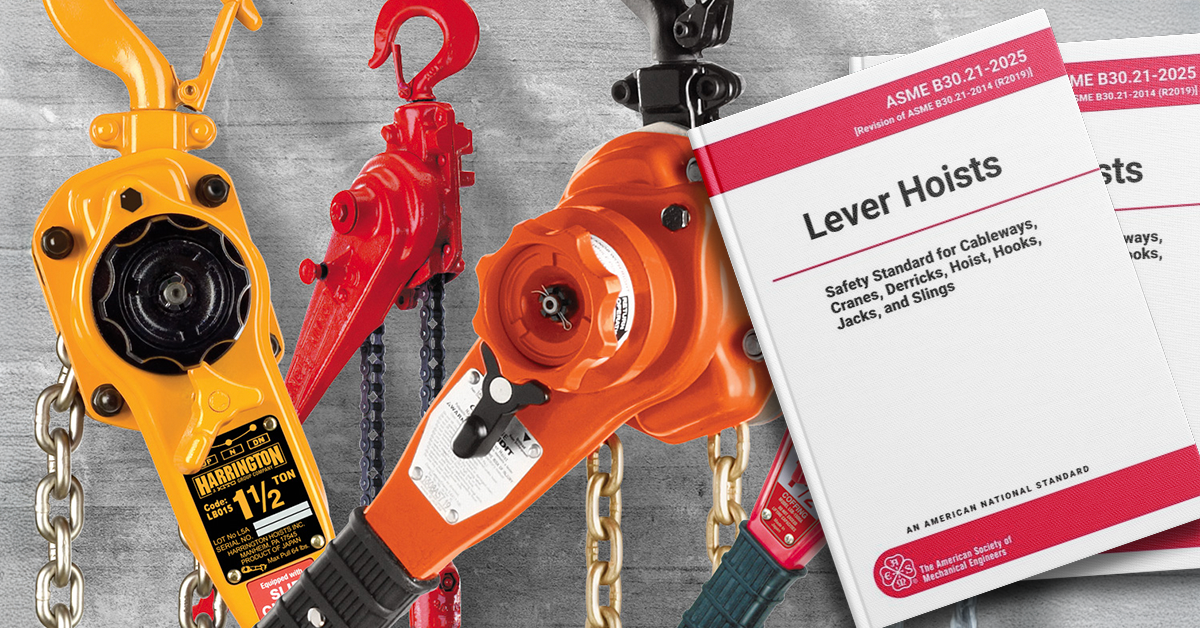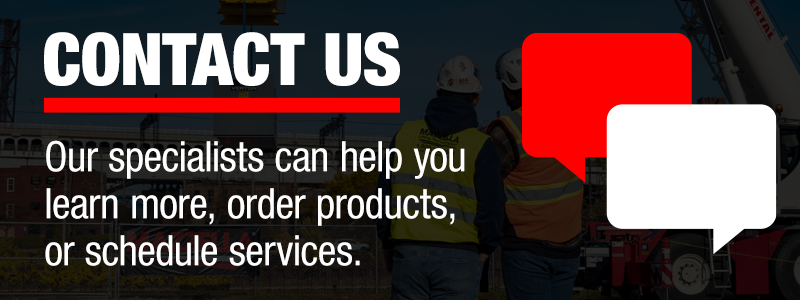Reviewing Updates & Revisions to ASME B30.21-2025 Lever Hoists Standard
Recently, ASME updated the ASME B30.21 Lever Hoists standards. This article breaks down the revisions, updates, and additions you need to know.
Recently, the American Society of Mechanical Engineers (ASME), one of the most influential governing bodies in the American engineering sphere, announced that they were updating their guidelines for ASME B30.21, which focuses on safety standards for lever hoists, cranes, hooks, jacks, and slings.
ASME’s network of former and current scientists, engineers, academics, and government officials meet every few years to set new standards, codes, and best practices for a variety of industries, including several lifting and rigging disciplines.
Last updated in 2014, the new standards were published Monday, February 10th, 2025, and there are notable changes throughout, including four sections revised in their entirety.
This article will break down the revisions, updates, and additions you need to know to stay compliant with ASME standards.

What Does ASME B30.21 Lever Hoists Cover?
First issued in 1989, ASME B30.21 provides guidance on the construction, operation, maintenance, and inspection of ratchet, pawl, and friction brake type lever chain, rope and web strap hoists used for lifting, pulling, and tensioning applications.
What Updates and Revisions Were Made to ASME B30.21- 2025?
Approved by ASME’s B30 committee in early 2025, B30.21-2025 contains many updates, including updates to:
- Definitions
- Inspection
- Figures
- Training requirements
- Product safety information
- Model and serial number requirements
The following updates appear in chronological order:
The Correspondence with the B30 Committee section was added to this standard.
Chapter 21-0 Scope, Definitions, Personnel Competence, and References
Section 21-0.2:
The terms “dust laden” and “moisture laden” were changed to “dust-laden and “moisture-laden.”
The phrase “Pins and bushings are press fit in their respective link plates … Rollerless chain may be provides on some equipment…” has been omitted.
Figure 21-0.2-1:
The title of this image changed from “Lever Hoist – Chain Type” to “Lever Hoist – Reeving.”
Figure 21.02-2:
The title “Fig. 21-0.2-2” was changed to “Figure 21.02-2.”
Figure 21.02-3:
The title “Guide and Load Sprocket-Strap” changed to “Guide and Load Sprocket for Strap Hoist.”
Section 21-0.4: References
ASME B30 – 2019 -Ropes and ASTM A1023 / A1023M Standard Specification for Carbon-Steel Wire Ropes for General Purposes were added as references for the 2025 standards.

Chapter 21-1 Construction and Installation
Section 21-1.1.4
In subparagraph a, “lifting more than the rated load,” was changed to “operating at more than the rated load.”
In subparagraph e, “lifting people,” was changed to “lifting or supporting people.”
Figure 21-1.2-6.1
The title of the image was changed from “Swivel Type Hook,” to “Swivel type Hook With Latch.” The mention of a swivel was also removed from the image.
Section 21-1.2-8
There was a slight formatting change in the final paragraph. No content was changed.
Section 21-1.2-12
The 2025 section on instruction manuals is a lot more comprehensive compared to the 2014 section. The 2025 version gives out specific details for documentation regarding wire ropes and synthetic ropes. You must have information in your instruction manuals on the following topics:
- Nominal rope diameter
- Rope construction
- Material type of load bearing yarns
- Recommended operating temperature range
- Minimum breaking force
Section 21-1.3: Translation of Non-English Documentation Into English
ASME B30.21- 2025 entirely revised their standards on translating safety and technical documents, providing more comprehensive requirements. Some of the additions include:
“The manufacturer shall provide instructions and one or more manuals for the operation, inspection, testing, maintenance, assembly, and disassembly of the hoist.”
“(a) The instructions and manuals shall be provided in a language specified by the purchaser at the time of the initial sale by the manufacturer.”
“(b) Pictograms used to identify controls shall be provided in a language specified by the purchaser at the time of the initial sale by the manufacturer.”
“(d) The finished translation shall be verified for compliance with (c) (1) through (c)(5) by a qualified person having an understanding of the technical content of the subject matter.”
Chapter 21-2 Inspection and Testing
Section 21-2.1.1: General
ASME B30.21’s inspection requirements now list the five types of inspections required for hoists:
- Initial inspection
- Preoperation inspection
- Frequent inspection
- Periodic inspection
- Inspection of hoists not in regular use
A paragraph was also added to the 2025 standards. Stating:
“In addition, the inspection shall be based on the recommendations in the equipment manufacturer’s manual and, when appropriate, recommendations by a qualified person based on review of the equipment application and operation.”
Tables 21-2.1.4-1 and Table 21-2.1.5-1 were also reformatted.
Section 21-2.2.3 Rope Inspection
In the 2025 version, instead of typing out the rope inspection requirements, ASME now directs you to look at ASME B30.30, paragraph 30-1.8.1 for wire rope inspection criteria or paragraph 30.2.8.1 for synthetic ropes.
Section 21-2.3.1 Operational Tests
“12 mo” was changed to “12 months.”
Section 21-2.3.2 Load Test
In sub-section 4, a semicolon was changed to a period.
Chapter 21-3 Operation and Operator Training
Some of the more notable additions can be found in the operation and operator training section.
Section 21-3.2.1 Before Operating Hoist
In sub-section e, instead of saying “before opening the hoist,” it now reads “before operating the hoist.”
Three subparagraphs were also added to the end of this section:
“(m) If the operation requires signals, a means of communication shall be established before operating the hoist.
(n) The hoist shall not be used to lift, support, or transport people.
(o) For a ratchet and pawl type lever hoist, ensure that the application will allow sufficient hoist travel to allow the pawl to disengage from the ratchet to release the tension on the hoist.”
Section 21-3.2.2
The title of this section was changed from “Handling the Load” was changed to “Rigging the Load.”
Chapter 21-4 Maintenance and Maintenance Training
Section 21-4.5.1 Rope Replacement
Subparagraph a was changed in its entirety. For rope replacement guidelines, ASME now directs readers to ASME B30.30, paragraph 30-1.8.2 for wire rope and paragraph 30-2.8.2 for synthetic rope.
Section 21-4.5.2 Rope Maintenance
Just like the rope replacement section, ASME now directs you to check ASME B30.30 standards for further information on wire rope and synthetic rope maintenance.
What is the Effective Date for New ASME B30.21 Standards?
The effective date for the ASME B30.21 standards will be February 10th, 2026, a year after their initial release.
“Construction, installation, inspection, testing, maintenance, and operation of equipment manufactured and facilities constructed after the effective date of this Volume shall conform to the mandatory requirements of this Volume… “
When Will the ASME B30.21 Standards Update Again?
The next edition ASME B30.21 is scheduled to be released in 2030.
However, while most ASME standards update every four to five years, B30.21 is an exception. This is the first update of B30.21 standards since 2014, an 11-year gap. And while a version was released in 2019, that version was simply a “reaffirmed” version of 2014’s standards. Before 2014, the last update was 2005, a nine-year gap.
Wrapping it Up
While the Summary of Changes section in the 2025 standards is rather long, most changes to ASME B30.21 are minor grammatical and editorial changes that are inconsequential to actual rigging practices. If your organization is already aware and follows current B30.21 standards, you shouldn’t be concerned.
However, you will want to ensure you’re aware of current ASME B30.30 – Ropes standards, as they are now referenced in sections concerning rope inspection and rope maintenance.
You should also pay attention to the new rules concerning translating safety and technical documents.
At Mazzella, we have a dedicated team of Rigging Inspectors that are independently trained and certified to inspect lifting slings rigging hardware, manual hoists, and below-the-hook lifting devices to all applicable OSHA and ASME standards. Schedule your inspection today. We also offer end user training for overhead lifting and rigging equipment.

Copyright 2025. Mazzella Companies.
